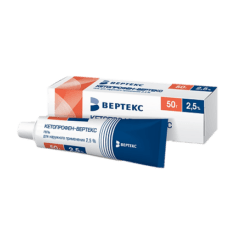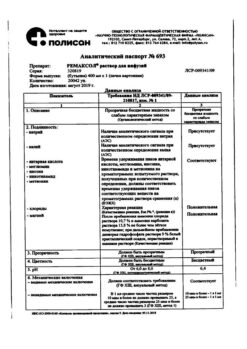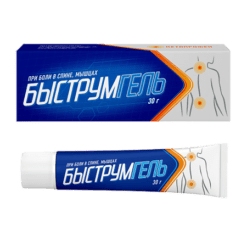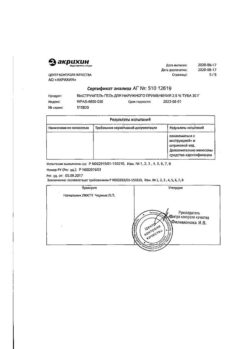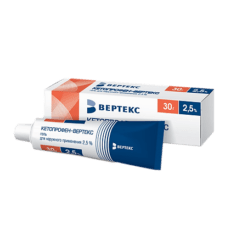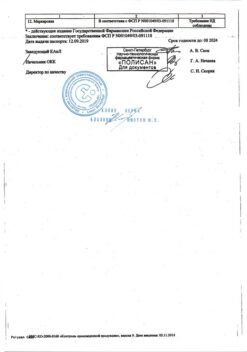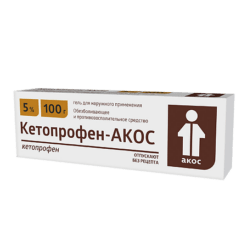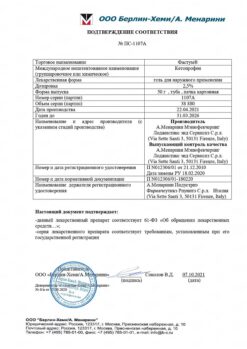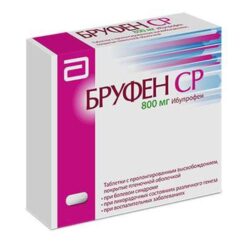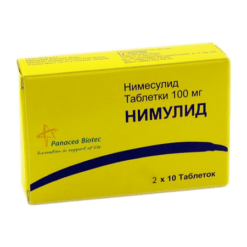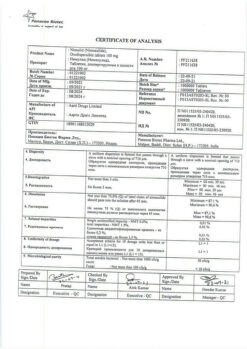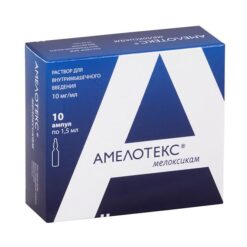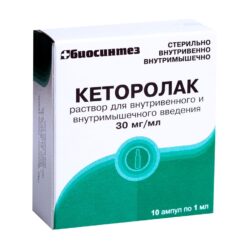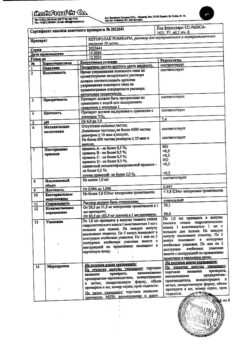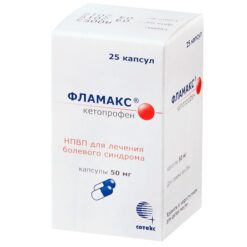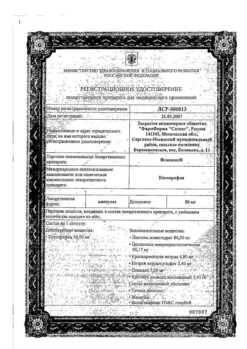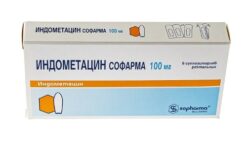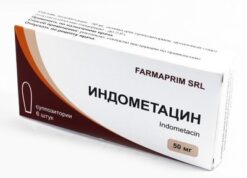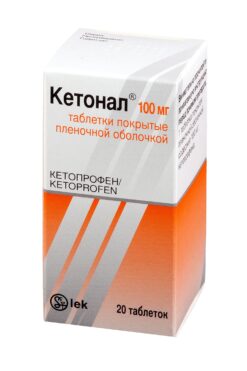No products in the cart.
Ketoprofen, 0.05/ml, 2 ml, 10 pcs.
€1.00
Out of stock
(E-mail when Stock is available)
Description
Pharmacodynamics
. Ketoprofen is a non-steroidal anti-inflammatory drug (NSAID), has anti-inflammatory, analgesic and antipyretic effects associated with inhibition of cyclooxygenase-1 (COX-1) and cyclooxygenase-2 (COX-2) activity that regulate prostaglandin (Pg) synthesis.
Pharmacokinetics
The bioavailability is more than 90%. Binding to plasma proteins – 99 %. Time of reaching maximum concentration (TCmax) while parenteral administration – 15-30 min.
Therapeutic concentration in synovial fluid is maintained for 6-8 hours. It does not cross the blood-brain barrier (BBB) in significant amounts. It is almost completely metabolized in liver by glucuronidation, has “first pass” effect through liver. It is eliminated mainly by kidneys. It does not cumulate.
Indications
Indications
Active ingredient
Active ingredient
Composition
Composition
1 ml of solution for injection contains:
the active ingredient:
ketoprofen – 50 mg;
excipients:
propylene glycol – 400 mg,
ethanol (rectified ethyl alcohol brand “Extra”) – 100 mg,
p> benzyl alcohol – 20 mg,
Sodium hydroxide solution 1 M – to pH 6.5-7.5,
water for injection – up to 1 ml.
How to take, the dosage
How to take, the dosage
Intravenously, intramuscularly.
Intravenous (intramuscular) – 100 mg (1 ampoule) 1-2 times a day.
Intravenous (intravenous) infusion should be administered only under hospital conditions.
Short intravenous infusion: 100-200 mg (1-2 ampoules) are dissolved in 100 ml of 0.9% sodium chloride solution and administered within 0.5-1 hour; it is possible to administer again after 8 hours.
Continuous intravenous infusion: 100-200 mg (1-2 ampoules) are dissolved in 500 ml of infusion solution (0.9% sodium chloride solution, Ringer’s solution, 5% dextrose solution) and administered within 8 hours; re-injection is possible after 8 hours.
Because of photosensitivity, the bottle or polyethylene bag with ketoprofen infusion solution should be wrapped in dark paper or aluminum foil.
The maximum daily dose is 200 mg.
Ketoprofen can be used in combination with centrally acting analgesics; it can be mixed with morphine in the same bottle.
The drug should not be taken for more than 2-3 days; if necessary, other dosage forms should be used.
Interaction
Interaction
Pharmaceutically incompatible with tramadol solution. Reduces the effectiveness of uricosuric drugs (TS), increases the effect of anticoagulants, antiaggregants, fibrinolytics, ethanol, the side effects of glucocorticosteroids and mineralocorticosteroids, estrogens; reduces the effectiveness of hypotensive drugs and diuretics. Concomitant use with other NSAIDs, glucocorticosteroids, ethanol, corticotropin may lead to ulceration and gastrointestinal bleeding, increased risk of renal dysfunction.
Concomitant administration with oral anticoagulants, heparin, thrombolytics, antiaggregants, cefoperazone, cefamandole and cefotetan increases the risk of bleeding. Increases the hypoglycemic effect of insulin and oral hypoglycemic drugs (recalculation of the dose is necessary). Increases the plasma concentration of verapamil and nifedipine, lithium preparations (Li+), methotrexate. Myelotoxic drugs increase the manifestation of hematotoxicity of the drug. If you take other drugs, you should consult your doctor.
Special Instructions
Special Instructions
The peripheral blood count and the functional state of the liver and kidneys should be monitored during treatment.
If 17-ketosteroid determination is necessary, the drug should be discontinued 48 hours before the study.
Ketoprofen administration may mask signs of infectious disease.
Dose reduction and close monitoring are necessary if renal and hepatic function is impaired.
To reduce the risk of gastrointestinal adverse events, the lowest effective dose should be used for the shortest possible course.
At the time of treatment, caution should be exercised when driving vehicles and engaging in other potentially hazardous activities requiring increased concentration and quick psychomotor reactions.
Contraindications
Contraindications
Side effects
Side effects
Gastrointestinal system disorders: NSAID gastropathy, abdominal pain, dyspepsia (nausea, vomiting, heartburn, flatulence, decreased appetite, diarrhea), stomatitis, liver function disorders; gastrointestinal mucosal ulceration, gastrointestinal, hemorrhoidal bleeding; taste changes.
Nervous system disorders: headache, dizziness, insomnia, agitation, nervousness, drowsiness, depression, asthenia, confusion or loss of consciousness, forgetfulness, migraine, peripheral neuropathy.
Sensory organs: tinnitus or ringing in the ears, blurred vision, conjunctivitis, dry mucous membrane of the eye, eye pain, conjunctival hyperemia, decreased hearing, vertigo.
Cardiovascular system disorders: increase in blood pressure and tachycardia.
Hematopoietic disorders: agranulocytosis, anemia, hemolytic anemia, thrombocytopenia, leukopenia.
Urinary system disorders: edematous syndrome, cystitis, urethritis, renal dysfunction, interstitial nephritis, nephrotic syndrome, hematuria.
Allergic reactions: skin rash (including erythematous, urticaria), skin itching, rhinitis, angioedema, bronchospasm, exfoliative dermatitis, anaphylactic shock.
Others: increased sweating, hemoptysis, nasal bleeding, myalgia, muscle twitching, shortness of breath, thirst, photosensitization, with prolonged use in high doses – vaginal bleeding.
If any of the side effects listed in the instructions worsen, or if you notice any other side effects not listed in the instructions, tell your doctor.
Overdose
Overdose
Symptoms: nausea, vomiting, abdominal pain, vomiting blood, melena, impaired consciousness, respiratory depression, seizures, renal dysfunction, renal failure.
In case of overdose symptomatic therapy, monitoring of respiratory and cardiovascular activity should be carried out, H2-histamine receptor blockers, Pg inhibitors are indicated. There is no specific antidote. Hemodialysis is ineffective.
Pregnancy use
Pregnancy use
The use of ketoprofen in I and II trimesters of pregnancy is possible only when the potential benefit to the mother exceeds the risk to the fetus.
The use of the drug in the III trimester of pregnancy is contraindicated.
If it is necessary to use ketoprofen during lactation, discontinuation of breastfeeding should be considered.
Similarities
Similarities
Additional information
| Shelf life | 2 years |
|---|---|
| Conditions of storage | At a temperature not exceeding 25 °C |
| Manufacturer | Sintez OAO, Russia |
| Medication form | solution for injections and infusions |
| Brand | Sintez OAO |
Other forms…
Related products
Buy Ketoprofen, 0.05/ml, 2 ml, 10 pcs. with delivery to USA, UK, Europe and over 120 other countries.


